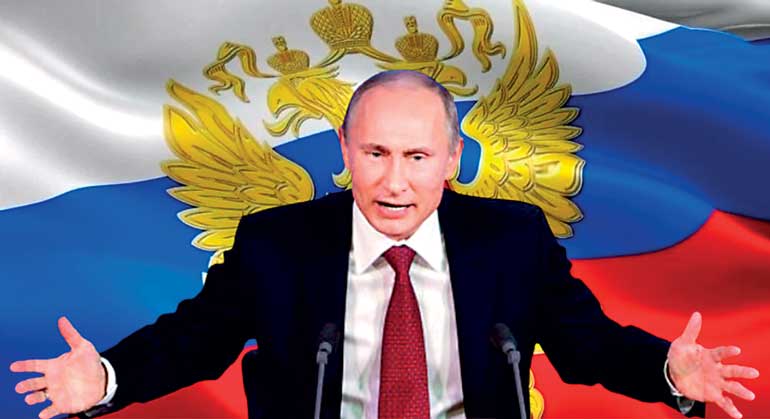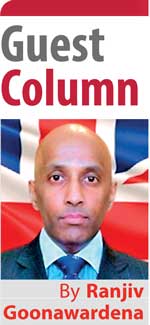Friday Dec 05, 2025
Friday Dec 05, 2025
Tuesday, 1 March 2022 02:48 - - {{hitsCtrl.values.hits}}

Russia accuses NATO countries of “flooding” Ukraine with weapons and the US of stoking tensions to contain Russia’s development
A reflection back into history perhaps might help us understand the current set of unfortunate events taking place in Ukraine; we need to understand the past in order to understand the present.
As the dust settled after World War I, Ukraine was defeated and divided; enabling the Soviets control of much of the country. The Ukrainian Bolsheviks, who had defeated the national government in Kiev, established the Ukrainian Soviet Socialist Republic, which on 30 December 1922 became one of the founding republics of the Soviet Union.
Then came a devastating blow in 1932, the great famine began and up to 10 million Ukrainians starved to death. It was made worse by the policies of the new head of the communist party, Joseph Stalin. At a subsequent time came the Great Terror; these were the two waves of Stalinist political repression and persecution in the Soviet Union, which resulted in the killing of some 681,000 people.
The calamity included 80% of the Ukrainian cultural elite and three-quarters of all the Ukrainian Red Army’s higher-ranking officers who were wiped out.
At the outbreak of the Second World War, Adolf Hitler invaded the Soviet Union in June 1941.
This was the beginning of four straight years of non-stop total war. Looking back into the battle of Kiev, German forces encircled and laid siege to the capital city. More than 600,000 Soviet soldiers were killed or taken captive there. The total losses inflicted upon the Ukrainian population during the then war was estimated between five and eight million, including over half a million Jews were killed by Nazi death squads, sometimes with the help of Ukrainian collaborators.
The republic was heavily damaged by the war. More than 700 cities, and 28,000 villages were destroyed. Material losses comprised an estimated 40% of Ukraine’s national wealth.
When Ukraine boomed following the Second World War, industrial output grew to 2.2 times from 1940 to 1955. Soviet Ukraine soon became a regional leader in industrial production, and an important centre of Soviet arms and high-tech research for industries.
Ukraine produced many prominent Soviet sports players, scientists, and artists over this period as well as much of the Soviet leadership, including Leonid Brezhnev, who ousted Nikita Khrushchev and became the Soviet leader from 1964 to 1982.
Another event that was profound occurred; on 26 April 1986, when a reactor in the Chernobyl Nuclear Power Plant exploded, resulting in the worst nuclear reactor accident in history.
The Soviet Union began to break apart under the weight of the “War of Laws,” which was the constant conflict between the Soviet Federal Government and its various republics, who were each seeking greater autonomy.
Then followed the unsuccessful August 1991 coup d’etat against Mikhail Gorbachev, the former President of the Soviet Union, which sealed the fate for Russia. A few days after the coup, Ukraine and Belarus declared their independence from the Soviet Union. The Baltic States, which had earlier declared their independence, sought international recognition.
On 24 August 1991, the Ukrainian parliament officially declared independence. But then the economy immediately sank into depression and lost 60% of its GDP from 1991 to 1999. A new currency, the Hryvnia, was introduced in 1996. The economy was stabilised by the end of the 1990s.
The Machiavellian second President of Ukraine set the stage for the 2004 ascendance of Prime Minister Viktor Yanukovych to the Presidency in elections which the Ukrainian Supreme Court ruled were rigged. Yanukovych was then thrown out of power in the peaceful Orange Revolution in favour of opposition leaders Viktor Yushchenko and Yulia Tymoshenko, who became President and Prime Minister. Yanukovych then regained the Prime Ministership in 2006, but lost a snap election just a year later that saw Tymoshenko become Prime Minister again.
In January 2009 the natural gas crisis culminated in Russia stopping the supplying of gas to Ukraine in the middle of winter to exert pressure. Since Ukraine is itself the main supply route to much of Europe, this was a catastrophic problem which needed to be resolved urgently. Tymoshenko eventually signed an agreement to reopen the pipeline, but not before Ukraine incurred major economic losses. As a result of the political fallout.
Yanukovych persisted by not going away; he was re-elected President again in 2010. And in October, 2011, Tymoshenko was sentenced to seven years in prison for abuse of office because of the signing of the natural gas deal with Russian President Vladimir Putin.
In 2012 the European Union and Ukraine began negotiations for it to join the 28 nations; thereby establishing a political and economic association between the parties.
Russia was totally against this agreement whereby Ukraine was going towards the influence of the European Union and Russia started placing embargo on Ukrainian goods. This resulted in a 10% decline in Ukrainian export revenue of $ 1.5 billion in losses as an attempt to put pressure on the Ukrainian government. This was intended to disrupt the signing of an association agreement with the EU, scheduled to be signed at the November 2013, Vilnius Summit.
President Viktor Yanukovych urged the parliament to adopt laws that would enable Ukraine to meet the EU’s criteria.
Yanukovych initially approached the European Union for a loan bailout which was offered but it was such a paltry amount consisting of $ 828 million which was inadequate, stating that his country would need at least $ 22 billion to cover the cost of upgrading the economy to European standards.
At this juncture Ukraine was very vulnerable, the Americans incited social unrest by providing financial, logistical and material assistance for the three-month-old Euromaidan protests which began at the end of 2013. During this time Yanukovych was feeling the economic pressure and abruptly suspended efforts to join the EU.
President Yanukovych then turned around and signed an agreement with Vladimir Putin, President of Russia, who offered $ 15 billion in financial aid with a 33% discount on Russian natural gas.
As a result, the Euromaidan protests escalated and became more violent, with many now calling for the ousting of Yanukovych and a rejection of the Russian deal in favour of a complete embrace of Europe.
The extent of the Obama administration’s meddling in Ukraine’s politics was breathtaking. Russian intelligence intercepted and leaked to the international media a Victoria Nuland.
The assistant secretary of state for European and Eurasian Affairs, in a telephone call with the US Ambassador to Ukraine Geoffey Pyatt discussed in detail their preferences for specific personnel in a post Yanukovych government. The US favoured candidates like Arseniy Yatsenyuk, the man who became prime minister after Yanukovych was out of
power. During the telephone call, Nuland stated enthusiastically that “Yats is the guy” who would do the best job.
Nuland and Pyatt were engaged in such planning at a time when Yanukovych was still Ukraine’s lawful president. It was startling to have diplomatic representatives of a foreign country with a country that routinely touts the need to intervene in democratic processes and the sovereignty of other nations; plotting about removing an elected government, and replacing it with officials meriting US approval. The agitator provocateur has now been promoted to high office as Ambassador Victoria Nuland, Under Secretary for Political Affairs.
After the collapse of the Soviet Union, Ukraine had the world’s third-largest nuclear weapons stockpile of which Ukraine had physical but not operational control. Russia alone controlled the codes needed to operate nuclear weapons. In a treaty called the Budapest Memorandum on security, assurance was given by nuclear powers Russia, the United Kingdom and America to respect the independence and sovereignty of the existing borders of Ukraine to refrain from the threat or use of force against the country. Those assurances played a key role in persuading the Ukrainian government in Kiev to give up the largest nuclear arsenal, consisting of some 1,900 strategic nuclear warheads.
The Warsaw Pact which was an Eastern military alliance consisting of Albania Bulgaria, Czechoslovakia, Eastern Germany, Hungary, Poland, Romania and the Soviet Union officially disbanded in 1991 following the dissolution of the Soviet Union.
Despite the termination of the Warsaw Pact, The North Atlantic Treaty Organization (NATO) western military alliance consisting of America, Canada and the Western Nations of Europe, in total had 30 member countries, which decided to expand its territory into Poland, Hungary, Czech Republic, Bulgaria, Estonia, Latvia, Lithuania, Romania, Slovakia, and Slovenia.
With the expansion of NATO, Russia seemed cornered by the military alliance therefore; perhaps being forced into a place of no possible escape. One would ponder; if NATO expands to Ukraine, then they would be utterly surrounded hence, will be unacceptable to the Russian psyche.
Russians think that deploying NATO troops in the former Eastern bloc countries bordering Russia is a threat to national security. This element has been expressed to NATO and the European Nations but they have been ignoring it for a considerable period of time.
Volodymyr Zelenskyy, the current President of Ukraine, as of January 2021, was preparing to formally apply for EU membership in 2024, in order to join the European Union in the 2030s.
President Putin has also argued that if Ukraine joined NATO, the alliance might try to recapture Crimea. Due to its strategic location and the navigability of the city’s harbours, Sevastopol, Crimea has been an important port and naval base throughout its history. Since the city’s founding in 1783 it has been a major base for Russia’s Navy Black Sea Fleet, and it was previously a closed city during the Cold War. The Port of Sevastopol is considered to be a key hold for maritime routes between the Black Sea and the Sea of Marmara; including the Mediterranean Sea, and the Atlantic Ocean. The port is one of the few warm deepwater ports available to Russia in the Black Sea.
Russia accuses NATO countries of “flooding” Ukraine with weapons and the US of stoking tensions to contain Russia’s development. Putin has complained, Russia has “nowhere further to retreat to; he stated, “Do they think we’ll just sit idly by?”
According to Putin, the West promised back in 1990 that NATO would expand “not an inch to the east” but did so anyway.
To conclude; would the above events be the motivator for the current state threatening world peace?
The above action has precipitated the current circumstances, perhaps as to why Russia has invaded Ukraine with a blitzkrieg pre-emptive strike. As they say in a game of chess you do not want to be checkmated because that will be the end of the game for Russia.